Address any questions or comments regarding this newsletter to the individual authors listed after each article or to its editors, Nathan Johanning, 618-939-3434, njohann@illinois.edu or Bronwyn Aly 618-695-6060, baly@illinois.edu. The Illinois Fruit and Vegetable News is available on the web at: http://ipm.illinois.edu/ifvn/. To receive or be removed from email notification of new postings of this newsletter, contact Nathan Johanning or Bronwyn Aly at the phone numbers or email addresses above.
In This Issue:
Upcoming Programs (listings for beginning and established growers)
News & Announcements (In Memory of Chris Doll)
Regional Reports (St. Louis metro east, southwestern Illinois (Waterloo), southern Illinois (Murphysboro), Dixon Springs)
Fruit & Vegetable Production & Pest Management (Cover Crop Could Solve Weed Problem for Edamame Growers, Farm Storage Facility Loans from USDA)
Upcoming Programs
See the University of Illinois Extension Local Food Systems and Small Farms Team’s website at:
http://web.extension.illinois.edu/smallfarm/ and the calendar of events at http://web.extension.illinois.edu/units/calendar.cfm?UnitID=629.
- 2021 Illinois Specialty Crops Conference, January 6-8, 2021. Save the dates and be on the lookout for information coming soon about this year’s virtual conference!
- 2020 Great Lakes Fruit, Vegetable, and Farm Market EXPO, December 8-10, 2020. This year will be a virtual, online event. If you have attended the EXPO in the past, you can expect this pre-conference brochure at the end of October. Online registration will open on November 1, 2020, with plans on having our normal full educational sessions with many trade show vendors. In addition to the pre-conference brochure, you will be able to find updated EXPO information, including a link to registration, at www.glexpo.com
- 2021 Kentucky Fruit and Vegetable Conference Online Every Tuesday in January 2021. For more information visit https://kyhortcouncil.org/2021-ky-fruit-vegetable-conference/
- Tuesday, Jan. 5 – General Session / Protected Ag Technologies
- Tuesday, Jan. 12 – Organic Production / Beginning Vegetable Production
- Tuesday, Jan. 19 – Advanced Fruit Production / Business Management
- Tuesday, Jan. 26 – Advanced Vegetable Production / Beginning Fruit Production
- 2021 Southern Illinois Fruit and Vegetable School, Wednesday, February 10, 2021. This will be a virtual conference that will be combining the Southern Illinois Tree Fruit School, the Southwestern Illinois Tree Fruit School and the Southern Illinois Small Fruit & Vegetable School. Save the date and be on the lookout for further information!
News & Announcements
In Memory of Chris Doll
UI Extension has lost one of its own. Carroll “Chris” Doll (1927-2020) passed away peacefully, with family at his side on Monday, October 12th at the grand age of 93. Chris spent his 30-year career with University of Illinois Extension based in the Edwardsville area, and though his horticultural expertise was expansive, he was most highly regarded for his fruit and horseradish production knowledge. We share not only our condolences to the family of Chris Doll but also a few memories from some of his mentees within UI Extension. In Chris’ own words “If I could have done it for free, I would have.” This link to Chris’s obituary includes information on memorials and a place to share memories https://legcy.co/344EOkM We share not only our condolences to the family of Chris Doll but also a few memories from some of his mentees within UI Extension.

Elizabeth Wahle (618-344-4230; wahle@illinois.edu)
I was saddened to hear of the passing of Chris Doll. In 1999 when I was first hired as a Research Specialist at Dixon Springs, tree fruit had just been added to the expected research and extension responsibilities for both myself and Jeff Kindhart. Chris was kind enough to spend quite a bit of time introducing us to all things tree fruit – we met many fine growers, hiked through numerous plantings, and I sampled my first fried pie from Flippin’s Fried Pies (road trip to an orchard field day). When I told Chris I didn’t have any experience with pruning apples and was going to need lots of guidance, he just smiled and said, “Well even if you make a wrong cut, its still going to be an apple tree.” I am truly thankful for all of the encouragement that Chris showed me through the years, and I know that I am just one of many.
Bronwyn Aly (618-382-2662; baly@illinois.edu)
Thoughts about Chris Doll …
I was a professor and extension specialist for the University of Illinois from 1984 to 2016. In 1990, my focus shifted to fruit and vegetable entomology, and in that role, I worked with Chris until he retired in the mid-1990s and then in his “retirement” for another 15-plus years. He was one of the people who influenced my career – and even retirement -- in significant ways. (I now have a small commercial orchard of my own, and I do some consulting to help other growers – might sound familiar to those of you who knew Chris.)
When I first started working on fruit and vegetable insect management problems in research and extension, I pictured myself as pretty progressive on integrated pest management, sustainability, and environmental issues. In fact, I was not behind the curve on these issues, but I was not the first … Chris had already made significant steps in his work with growers. I began writing insect updates for his Fruit News newsletter; a few years later he would send regular updates to me for the Illinois Fruit and Vegetable News. We worked together on Extension programs and cooperated on research to solve specific problems, especially in apples, peaches, and, of course, horseradish. We developed a friendship based on deep mutual respect. I had chosen to work in an Extension position because I thought that service to growers and the public would benefit society. Don Kuhlman, Bill Whiteside, and especially Chris Doll reinforced that view through their examples and influenced my entire career.
I am happy to have known and worked with Chris. His influence on my career and my service to Illinois growers was profound. I’ll miss him. Illinois growers will miss him. To his children, grandchildren, and great-grandchildren … thank you for sharing him with us.
Rick Weinzierl, Weinzierl Fruit and Consulting, LLC (217-621-4957; raweinzierl@gmail.com)
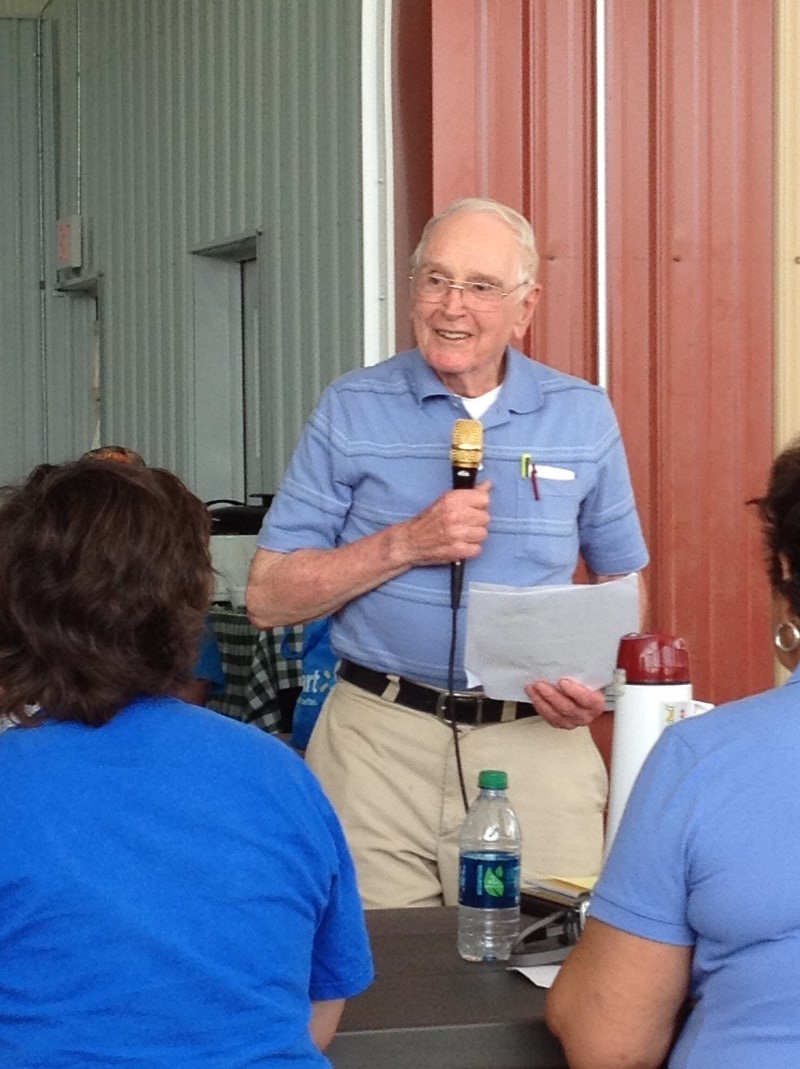
Chris was an amazing horticulturalist, mentor and inspiration especially in fruit production. I met Chris in college on a fruit production class tour of “the back 40,” his home orchard, which was nothing short of a botanical garden of tree fruits. I never quite knew why, but he always showed me so much support, especially once I started in Extension. He went out of his way to sit in on some of my graduate school presentations, always talked to me at conferences, and send that “keep up the good work” email, especially about the IL Fruit & Vegetable News. Chris was truly a great mentor and friend. I hope I can do a small part to carry on the service he provided to the region. My thoughts and prayers with his family and you will be missed!
Nathan Johanning (618-939-3434; njohann@illinois.edu)
Chris was a breeder of horseradish for many years and helped me tremendously to transition part of my research program at SIUC to horseradish breeding. During those years we walked in many horseradish fields and I was like a sponge, trying to soak up as much knowledge as I could. I miss his gentle nature and all the horseradish conversations we had over the years.
Alan Walters, Professor, Vegetable Science, Southern Illinois University Carbondale
From…Illinois Fruit and Vegetable News Vol. 20, No. 8, August 12, 2014
From the July twilight meeting at the St. Charles Horticulture Research Center … Many of you will recognize the two experts pictured below. Bill Whiteside (left) and Chris Doll (at the wheel) attended and chatted with many who were present. I’m not sure a John Deere Gator ever carried more knowledge and experience than this one did in July.
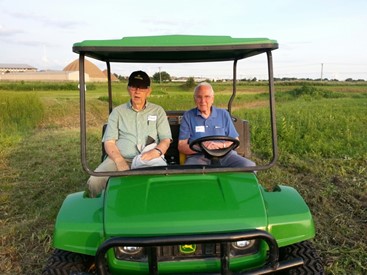
Bill Whiteside (L) and Chris Doll (R) at the at the St. Charles Horticulture Research Center Twilight Meeting in July 2014.
Richard Hentschel (630-584-6166; hentschel@illinois.edu)
Regional Reports
From the St. Louis Metro east… This crazy year is successfully winding down for many. Demand continues to be high for pumpkins and apples. Harvest has concluded for Cameo and Braeburn, and has moved into Evercrisp and Fuji. The area has received two light frost since the last newsletter, finishing up any remaining field tomatoes, peppers and other cold sensitive vegetables. Cleanup, including plastic removal is in progress. Temperatures have not dropped enough to cause any damage to apples, and little to none on pumpkins in the field.
On behalf of Extension, we extend our sincere condolences to the family of Adrian Crook on his passing after a valiant battle against lymphoma at the age of 82. He is survived by his wife Marcella of 58 years and their children. Adrian farmed full time just south of Waterloo on their centennial farm, including operation of a fruit orchard. https://www.quernheimfuneralhome.com/obituary/Adrian-Crook
Elizabeth Wahle (618-344-4230; wahle@illinois.edu)
From southwestern Illinois (Waterloo)… Fall has been very dry until about a week ago or so when the area had about 2” of rain and more rain is forecasted for next week. Temperatures bounced from hot to cold throughout this early part of fall. We had our first frost over most of the area on 10/2 with temperatures into the mid to upper 30s. This was a little earlier than most of us expected but it is what it is. The next week we had temperatures up in the mid 80s for highs. Then we had a few more frosty nights around 10/15 and 16. Now we have gotten more in a cool fall pattern of highs in the 60s with some cooler temperatures for next week. Until the last week or so we had a long run of sunny days which had been great for some fall crops and to get consumers out to fall markets and farms.
Markets for pumpkins and fall vegeteables have been very good. The weather has also been cooperative for the most part. After a very wet summer the almost 2 months of dry was fairly welcomed. This prevented some further disease and fruit quality issues such as bacterial spot and other fruit rots on pumpkins, helped to prevent the further spread of downy mildew on pumpkins, and less cracking and rot on tomatoes for example. Additionally, harvest is easier when the soil is dry and we have cleaner pumpkin fruit. Overall, I think it has been a good pumpkin season. I felt yield was about average and not a record breaking crop but good solid yield. Demand has been very good and I’m happy that many people are looking local for pumpkins as well as other fresh fruits and vegetables. The early frost was not ideal, but most made it work. We did see injury on fruit surface especially on white varieties and other fair skinned specialty pumpkins. Others had some minor injury but most not noticeable. It was a still night and good pumpkin leaf canopy actually protected many fruit from frost damage although you only get that protection the first frosty night but it gain some added yield that would have otherwise been damaged. This is another good reason to keep up the canopy as best you can into the fall.
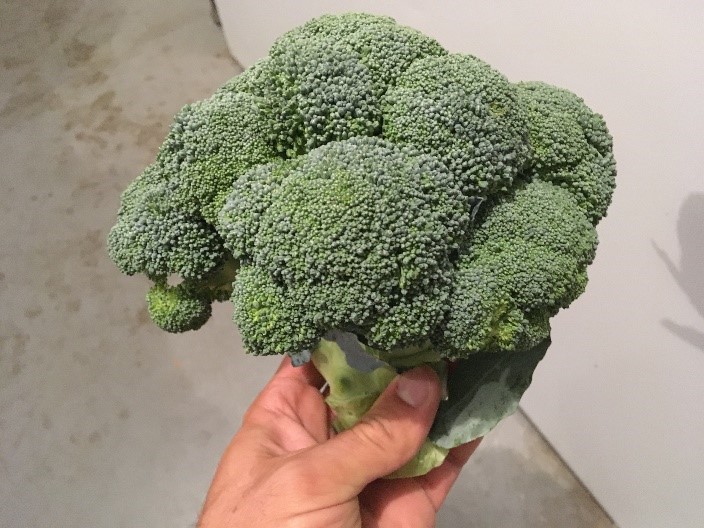
First broccoli harvest from fall plantings. Photo: N. Johanning
Some of our fall planted crops, did not benefit from such dry conditions. Fall greens and cole crops struggled at times where irrigation wasn’t available. I harvested my first fall broccoli recently. I transplanted broccoli late July and a second planting in mid August. The first planting is just about done and the second planting will be coming soon. The first planting some plants were lost due to the heavy rains in August and the second struggled to take off at first due to limited rain. The second planting head size is more variable due to the weather. The variety I used this year was ‘Millenium’ so far it has done well for the season. The skin was a little tough on this first planting, but I don’t know if that is varietal or simple due to the dry weather during head formation; we will see what the second planting is like. Hopefully the weather will be kind to our remaining fall plantings!
Don’t forget we still have time to plant fall cover crops especially cereal rye and other grains. This is a great way to hold and build the soil over the winter!
Nathan Johanning (618-939-3434; njohann@illinois.edu)
From southern Illinois (Murphysboro)… Fall has officially come to southern Illinois, the leaves are changing color and starting to drop. Thursday night (10/15) we got a light frost. We also saw quite a bit of rain over the weekend and into the early part of the week.The Jackson County high tunnel is full of cool season crops. The carrots, beets, and radishes are growing well; with some of the radish varieties ready to harvest soon. Romaine lettuce, kale, swiss chard, and broccoli were transplanted into the tunnel, and in the outside raised beds. The tunnel sides are opened and closed as needed to maintain a good growing environment. Plants will be covered with row covers when temperatures drop below the threshold.
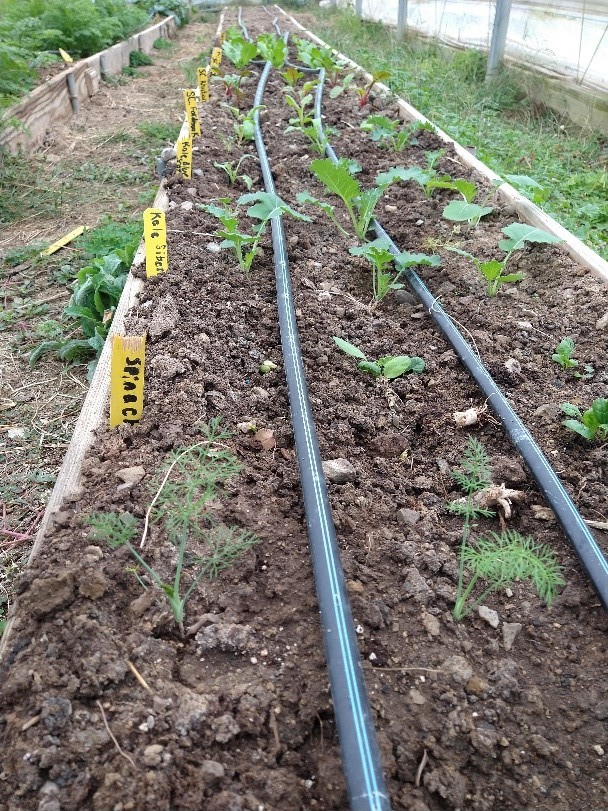
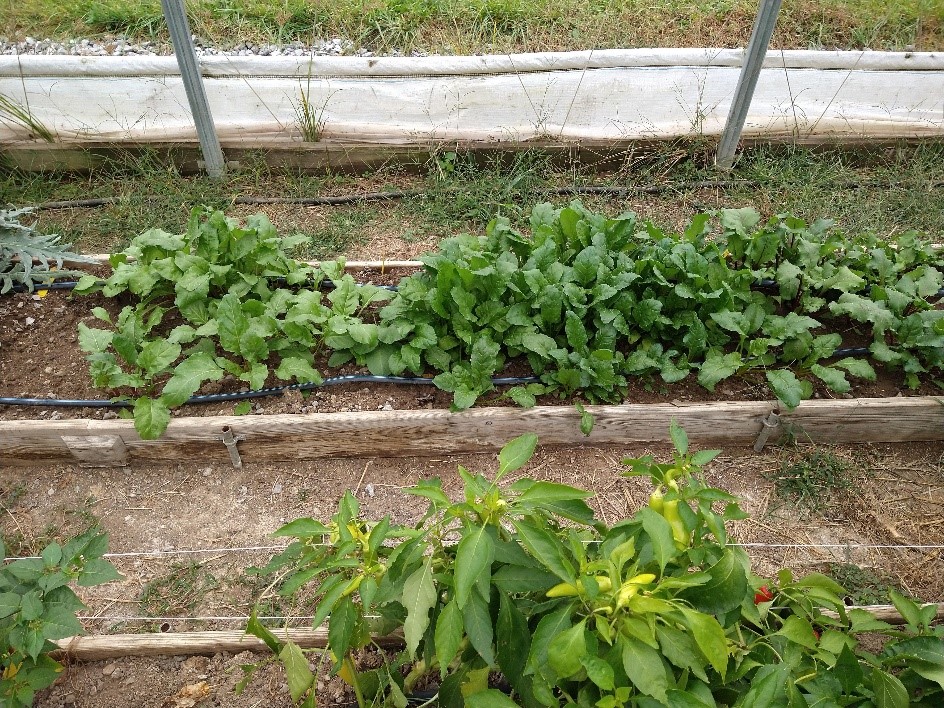
Various cool season crops planted in the high tunnel at the Jackson County Extension office. Photos by K. Bell.
Katie Bell (618-687-1727; klbell@illinois.edu)
From Dixon Springs Ag Center…We have been enjoying great fall weather, with an ample amount of rain earlier in the week that helped to settle the dust.
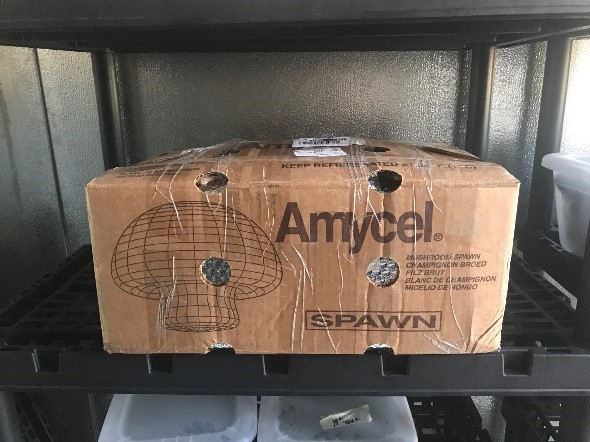
Mushroom spawn being stored in cooler at DSAC awaiting planting in high tunnel at DSAC. Photo by B Aly.
We have begun to remove our summer crops (cucumbers, tomatoes, & peppers) from the hydroponic tunnel and the in-ground tunnel. All plant material is taken out of the tunnels and hauled away to a compost pile. Leaving plant material inside the tunnels could allow disease pathogens to overwinter, setting up the possibility for increased disease pressure next season. This simple cultural control practice can help to save a lot of headaches and ultimately dollars as you consider the long-term use of your high tunnel. All stakes, dutch buckets, and any reusable items from the tunnels will be washed and sanitized before their next uses, again a basic cultural control practice that will help to manage future disease problems. I guess it literally is like the saying, “An ounce of prevention is worth a pound of cure” but just replace a couple of words, “An ounce of bleach is worth a pound of fungicide.” Preparations, including the addition of soil amendments and steam pasteurizing beds, are being made to grow a few portabello and white button mushrooms in a couple of the in-ground beds, along with plots of cut and come again lettuce and spinach as well.
The lettuce table has been set up with a mixture of red and green lettuce and bok choi varieties now that the temperature inside the hydroponic tunnel has cooled down. The strawberries in the vertical stacks have also really responded to the cooler temperatures, with both increased fruit load and size. The ‘Joan J’ and ‘Double Gold’ raspberries are continuing to set very tasty fruit.

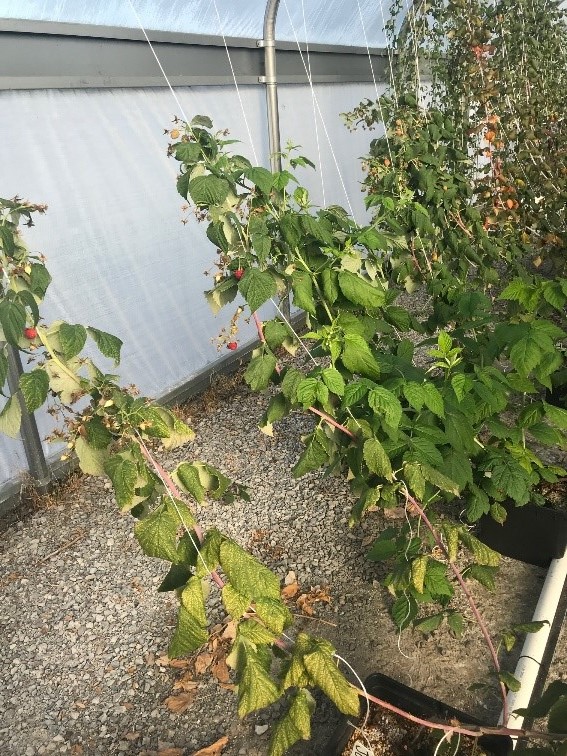
(Left)‘Monterey’ strawberries producing a nice fall crop in vertical stacks within the high tunnel at DSAC; (Right) ‘Joan J’ thornless raspberries in hydroponic production setting first crop of fruit in high tunnel at DSAC. Photos by B. Aly.
The second planting of lettuce, kale, and spinach was set out the first week of October and the first harvests from the first planting were also taken the first week of October. The fourth and fifth plantings of carrots was direct seeded the first and third weeks of October, with two more plantings scheduled for the first week of November and December. This is year 2 of 2 for the research trials included in the IDOA Specialty Crop Block Grant Utilizing High Tunnels to Maximize Winter Vegetable Production.
The deer tracks inside the youth tunnel serve as a good reminder to stay diligent with wildlife control as we move into cooler months, especially for those trying to grow crops for fall and winter markets. This time of year as many plants are senescing, deer will be looking harder for any tender plants, often changing their normal browse patterns (also, I image rut season comes into play as well) so make sure you have strategies in place to keep them out of your plantings, both inside and outside of high tunnels.
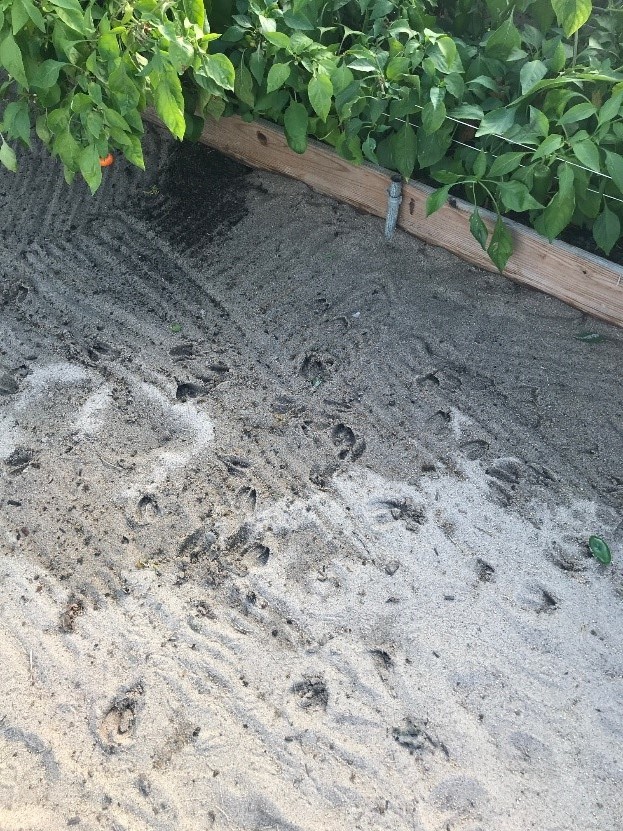

(Left) Deer tracks inside high tunnel at DSAC; (Right) Deer netting (attached only on endwalls of this tunnel) can help to deter mammals like deer, opossum, and raccoons but without netting on the sidewalls or any other openings on your high tunnel, these critters can still easily access crops growing inside. Photos by B. Aly.
Another mammal pest that poses problems this time of year include voles. These critters can be quite problematic in orchards, perennial small fruit plantings, and plasticulture strawberries so don’t forget to scout and follow control management strategies outlined on pages 122-123 of the Midwest Fruit Pest Management Guide.
I will continue to put in a plug for our Illinois Extension Local Foods & Small Farms YouTube channel. Video content is continuing to be added to the channel weekly, with content being organized into playlists based on subject matter or specific vlog locations, including Local Food Happenings at DSAC , The Urban Ag Connect Vlog Series and the Beginning Food Production Resources.
Bronwyn Aly (618-382-2662; baly@illinois.edu)
Fruit & Vegetable Production & Pest Management
Cover Crop Could Solve Weed Problems for Edamame Growers – Article written by Lauren Quinn, 217-300-2435 and dated October 13, 2020 and posted on ACES News
SOURCES
Martin Williams
217-244-5476
URBANA, Ill. – For vegetable growers, weeds can mean lost income from reduced yield and foreign plant matter contaminating the harvest. But for many crops, particularly vegetable legumes, weed management options are very limited.
Cover crops such as cereal rye reduce weed competition in grain soybean, but most vegetable legume growers have yet to adopt the practice due to the potential for reduced germination and yield in thick cover crop residue. However, a new study from the University of Illinois and USDA Agricultural Research Service (USDA-ARS) shows early-terminated rye could be a promising part of an integrated weed management program for some vegetable legumes, including edamame.
“In general, the more cover crop biomass you have, the better the weed suppression. We found a sweet spot in an earlier experiment with edamame when we terminated rye at tillering and then planted into the stubble. The rye provided measurable weed suppression without harming the crop,” says Marty Williams, USDA-ARS ecologist and affiliate professor in the Department of Crop Sciences at Illinois. “We wanted to follow that up with yield experiments for edamame, and decided to broaden to some mainstream vegetable legumes including snap bean and lima bean.”
Williams and his research team looked at weed density and biomass in bare soil and in plots planted with a rye cover crop terminated at tillering, about a month before vegetable crops were planted. For three growing seasons, the researchers either sprayed weeds with one of the few registered herbicides; hand-pulled weeds in addition to spraying; or left weeds alone to grow. Then they gathered information on weed suppression, crop establishment and yield, as well as soil moisture and nitrogen.
In edamame and snap bean, early-terminated rye reduced weed biomass by 53% and 73%, respectively, compared with bare soil. And, consistent with his earlier studies, Williams found no reductions in edamame establishment or yield. Yet, the res
“We found the early-terminated rye system worked well in edamame. The rye suppressed weed biomass without impacting the crop.” Williams says. “For lima bean, the system failed. For snap bean, there is room for improvement.”
He suspects the poor performance in lima and snap bean is related to the crops’ weak ability to fix nitrogen in soils depleted of the nutrient by the cover crop. In turn, poor crop growth and canopy development favored the weeds.
“We had a problem with crop establishment in lima bean in the rye stubble,” Williams says. “And while snap bean established well, crop growth was hampered by the nitrogen-starved environment in rye stubble – one of the key traits providing weed suppression.”
Edamame, like soybean, can grow without applied nitrogen because it benefits from symbiosis with nitrogen-fixing bacteria. Williams’ group is currently doing follow-up research to exploit biological nitrogen fixation in snap bean, which would have implications beyond weed management.
Although early-terminated rye worked well in edamame, the cover crop didn’t eliminate the need for other weed control measures.
“Early-terminated rye alone is not going to solve all weed problems,” Williams says. “It reduced the weed load, but did not eliminate it. Early-terminated rye roughly halved the weeds compared to bare soil. The weed load was further reduced by using an herbicide, too. Hand-weeding, while generally used as a last-resort tactic, was used in this system to entirely eliminate interference with the crop and weed seedbank additions. That combination is the most effective approach.”
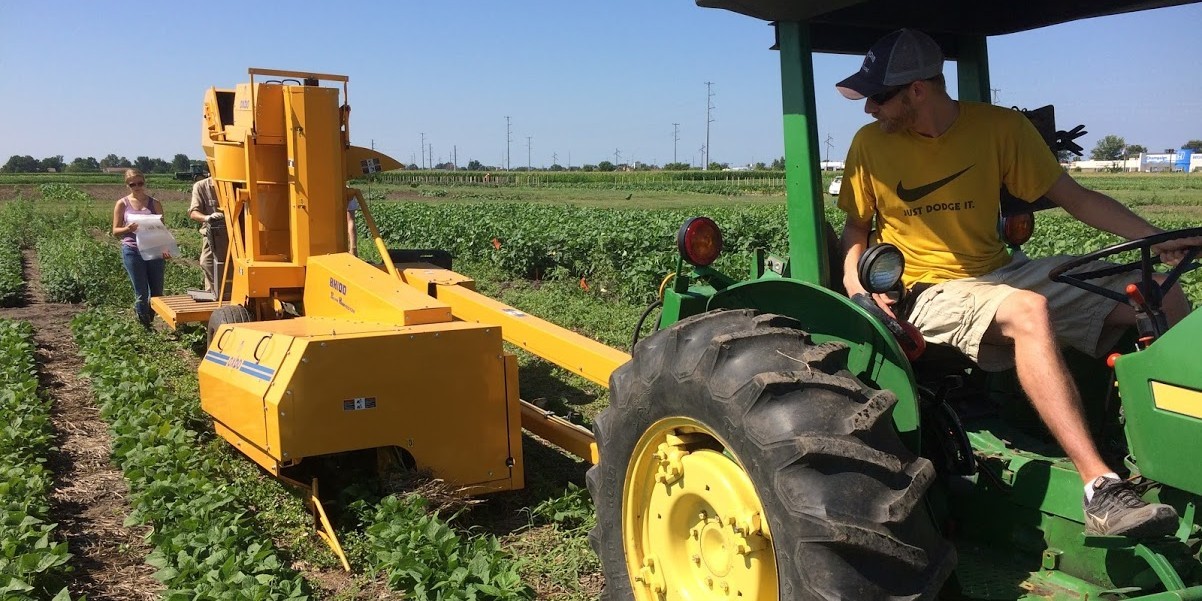
Machine harvest of edamame, lima bean, and snap bean plots in field trials near Urbana, IL. The field trials examined an early-terminated cereal rye cover crop as a component of an integrated weed management system. Photo by Marty Williams
The article, “Integrated weed management strategies with cereal rye mulch in processing vegetable legumes,” is published in Agronomy Journal [DOI: 10.1002/agj2.20349]. Authors include Nicholas Korres, Nicholas Hausman, James Moody, Yasin Kitis, and Martin Williams. The research was supported by the USDA-ARS.
The Department of Crop Sciences is in the College of Agricultural, Consumer and Environmental Sciences at the University of Illinois.
Farm Storage Facility Loans from USDA Farm Service Agency
For growers exploring options to install, expand, or revamp on-farm storage facilities, including cold storage buildings, refrigerated trucks, food safety related equipment, and more, check out the USDA Farm Service Agency Farm Storage Facility Loan. I have included the fact sheet in this newsletter, but if interested, I would encourage growers to contact their local USDA FSA office. Many row crop farmers utilize this loan for installing new or upgraded grain bins, but it can also be utilized by specialty crop farmers as well.
Bronwyn Aly (618-382-2662; baly@illinois.edu)
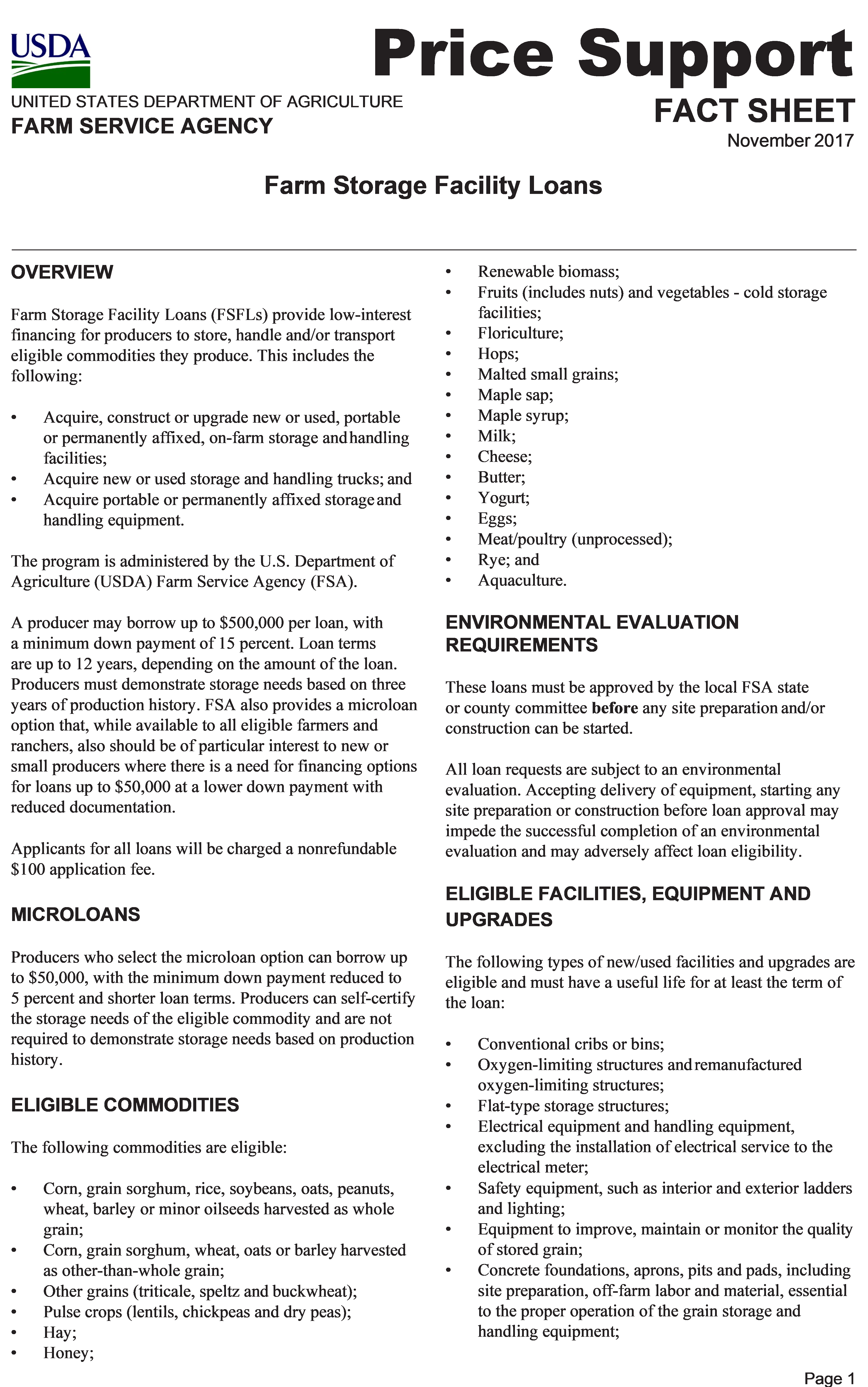
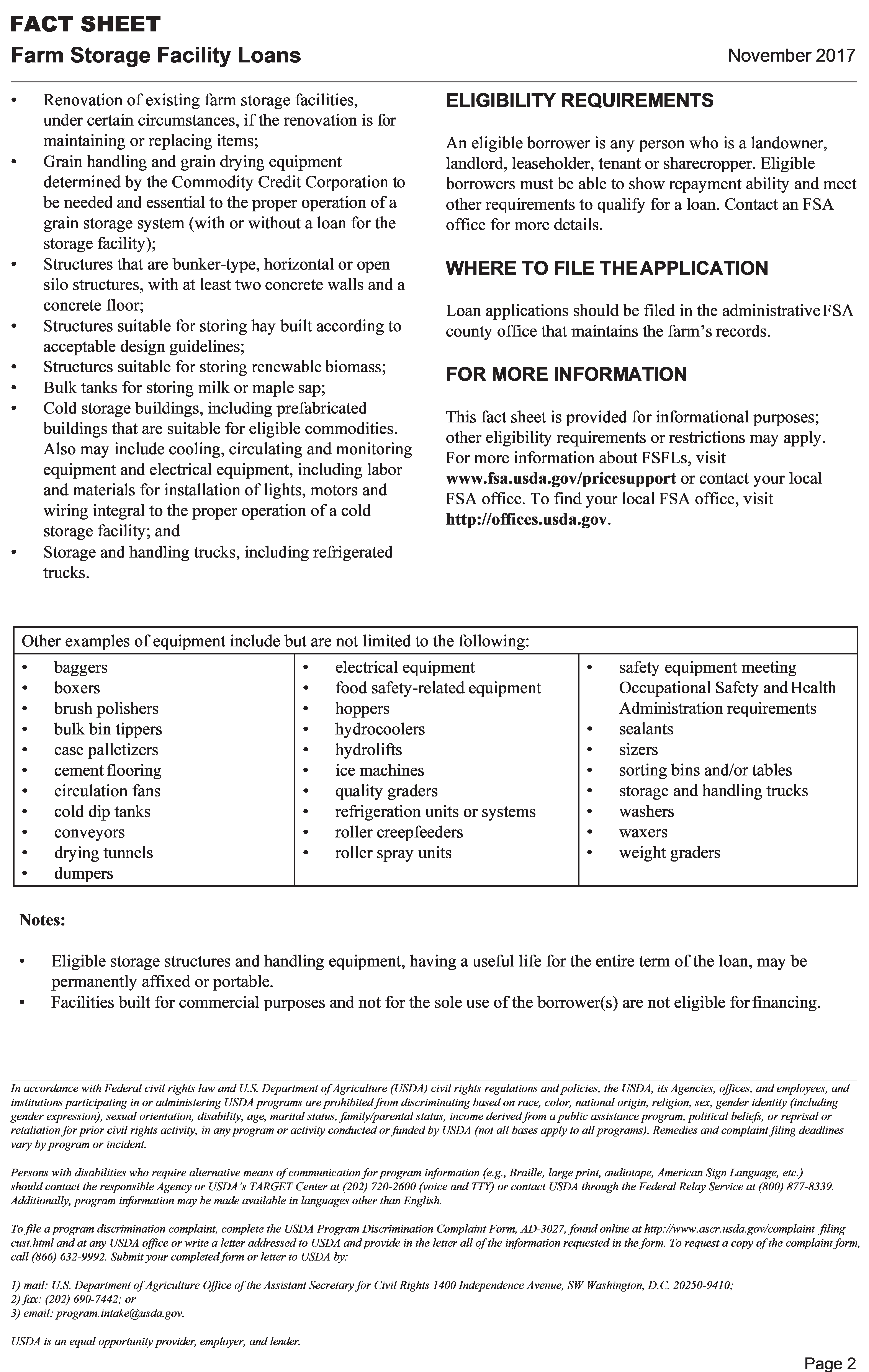
Less Seriously
Halloween Food Jokes
A mix bag of funny Halloween food jokes that will be the prefect recipe to get you laughing this Halloween!
Q: What’s the best thing to put in a Pumpkin pie?
A: Your teeth!
Q: What is a scarecrow’s favorite fruit?
A: Straw-berries!
Q: What day does Mr Potato head hate the most?
A: Fry-day!
Q: What do you get if you divide the circumference of a jack-o-lantern by its diameter?
A: Pumpkin pi!
Q: What’s worse than finding a worm in your apple?
A: Finding half a worm in your apple!
Q: What does an evil hen lay?
A: Deviled eggs!
Q: Why can’t you starve to death on a beach?
A: Because of the sand which is there!
Q: Which is the left side of a pumpkin pie?
A: The side that is not eaten!
Q: Why did the zombie walk around with a fig?
A: It couldn’t find a date!
Q: What did a pirate pay for his corn?
A: A buccaneer!
Q: Why was the strawberry sad?
A: Because her mom was in a jam!
Q: What’s the worst vegetable to serve slime monster?
A: Leeks!
Q: Why did the silly witch stare at the can of orange juice?
A: Because it said ‘concentrate’!
Q: Did the wild grape cry when the werewolf stepped on it?
A: No, it just let out a little wine.
Q: How do the scarecrow fix a cracked pumpkin?
A: With a pumpkin patch!
Q: What did the witch say to the strawberry?
A: If you weren’t so fresh, you wouldn’t be in this jam.
University of Illinois Extension Specialists in Fruit and Vegetable Production & Pest Management
Extension Educators – Local Food Systems and Small Farms |
||
Bronwyn Aly, Gallatin, Hamilton, Hardin, Pope, Saline, and White counties |
618-382-2662 |
|
Katie Bell, Franklin, Jackson, Perry, Randolph, & Williamson counties |
618-687-1727 |
|
Sarah Farley, Lake & McHenry counties |
847-223-8627 |
|
Nick Frillman, Woodford, Livingston, & McLean counties |
309-663-8306 |
|
Laurie George, Bond, Clinton, Jefferson, Marion, & Washington counties |
618-548-1446 |
|
Zachary Grant, Cook County | 708-679-6889 | |
Doug Gucker, DeWitt, Macon, and Piatt counties |
217-877-6042 |
|
Erin Harper, Champaign, Ford, Iroquois, and Vermillion counties |
217-333-7672 |
|
Grace Margherio, Jackie Joyner-Kersee Center, St. Clair County |
217-244-3547 |
|
Grant McCarty, Jo Daviess, Stephenson, and Winnebago counties |
815-235-4125 |
|
Katie Parker, Adams, Brown, Hancock, Pike and Schuyler counties |
217-223-8380 |
|
Kathryn Pereira, Cook County |
773-233-2900 |
|
James Theuri, Grundy, Kankakee, and Will counties |
815-933-8337 |
|
Extension Educators – Horticulture |
||
Chris Enroth, Henderson, Knox, McDonough, and Warren counties |
309-837-3939 |
|
Richard Hentschel, DuPage, Kane, and Kendall counties |
630-584-6166 |
|
Andrew Holsinger, Christian, Jersey, Macoupin, & Montgomery counties |
217-532-3941 |
|
Extension Educators - Commercial Agriculture |
||
Elizabeth Wahle, Fruit & Vegetable Production |
618-344-4230 |
|
Nathan Johanning, Madison, Monroe & St. Clair counties |
618-939-3434 |
|
Campus-based Extension Specialists |
||
Kacie Athey, Entomology |
217-244-9916 |
|
Mohammad Babadoost, Plant Pathology |
217-333-1523 |
|